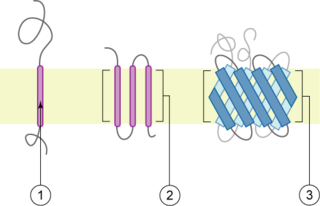
Peptide transporter 1 also known as solute carrier family 15 member 1 (SLC15A1) is a protein that in humans is encoded by SLC15A1 gene. PepT 1 is a solute carrier for oligopeptides. It functions in renal oligopeptide reabsorption and in the intestines in a proton dependent way, hence acting like a cotransporter.

Sodium bicarbonate cotransporter 3 is a protein which in humans is encoded by the SLC4A7 gene.

Solute carrier family 22 member 2 is a protein that in humans is encoded by the SLC22A2 gene.

Solute carrier organic anion transporter family member 1B1 is a protein that in humans is encoded by the SLCO1B1 gene. Pharmacogenomic research indicates that genetic variations in this gene are associated with response to simvastatin. Clinical guidelines exist that can guide dosing of simvastatin based on SLCO1B1 gene variant using genotyping or whole exome sequencing.

Equilibrative nucleoside transporter 2 (ENT2) is a protein that in humans is encoded by the SLC29A2 gene.

Solute carrier family 22 member 3 (SLC22A3) also known as the organic cation transporter 3 (OCT3) or extraneuronal monoamine transporter (EMT) is a protein that in humans is encoded by the SLC22A3 gene.

Concentrative nucleoside transporter 2 (CNT2) is a protein that in humans is encoded by the SLC28A2 gene.

Solute carrier family 22 member 11 is a protein that in humans is encoded by the SLC22A11 gene.

Concentrative nucleoside transporter 1 (CNT1) is a protein that in humans is encoded by the SLC28A1 gene.

Neutral amino acid transporter A is a protein that in humans is encoded by the SLC1A4 gene.

Sodium-dependent phosphate transport protein 2B (NaPi2b) is a protein that in humans is encoded by the SLC34A2 gene.

Multidrug and toxin extrusion protein 1 (MATE1), also known as solute carrier family 47 member 1, is a protein that in humans is encoded by the SLC47A1 gene. SLC47A1 belongs to the MATE family of transporters that are found in bacteria, archaea and eukaryotes.

Solute carrier organic anion transporter family member 2B1 also known as organic anion-transporting polypeptide 2B1 (OATP2B1) is a protein that in humans is encoded by the gene SLCO2B1.

Sodium-coupled monocarboxylate transporter 1 is a protein that in humans is encoded by the SLC5A8 gene.

Sodium-dependent phosphate transport protein 1 is a protein that in humans is encoded by the SLC17A1 gene.

Solute carrier family 13 member 3 also called sodium-dependent dicarboxylate transporter (NaDC3) is a protein that in humans is encoded by the SLC13A3 gene.

Solute carrier family 13 member 2 is a protein that is encoded in humans by the SLC13A2 gene.

Solute carrier family 22 member 7 is a protein that in humans is encoded by the gene SLC22A7.

Solute carrier family 6, member 18 also known as SLC6A18 is a protein which in humans is encoded by the SLC6A18 gene.

The organic anion transporter 1 (OAT1) also known as solute carrier family 22 member 6 (SLC22A6) is a protein that in humans is encoded by the SLC22A6 gene. It is a member of the organic anion transporter (OAT) family of proteins. OAT1 is a transmembrane protein that is expressed in the brain, the placenta, the eyes, smooth muscles, and the basolateral membrane of proximal tubular cells of the kidneys. It plays a central role in renal organic anion transport. Along with OAT3, OAT1 mediates the uptake of a wide range of relatively small and hydrophilic organic anions from plasma into the cytoplasm of the proximal tubular cells of the kidneys. From there, these substrates are transported into the lumen of the nephrons of the kidneys for excretion. OAT1 homologs have been identified in rats, mice, rabbits, pigs, flounders, and nematodes.

















